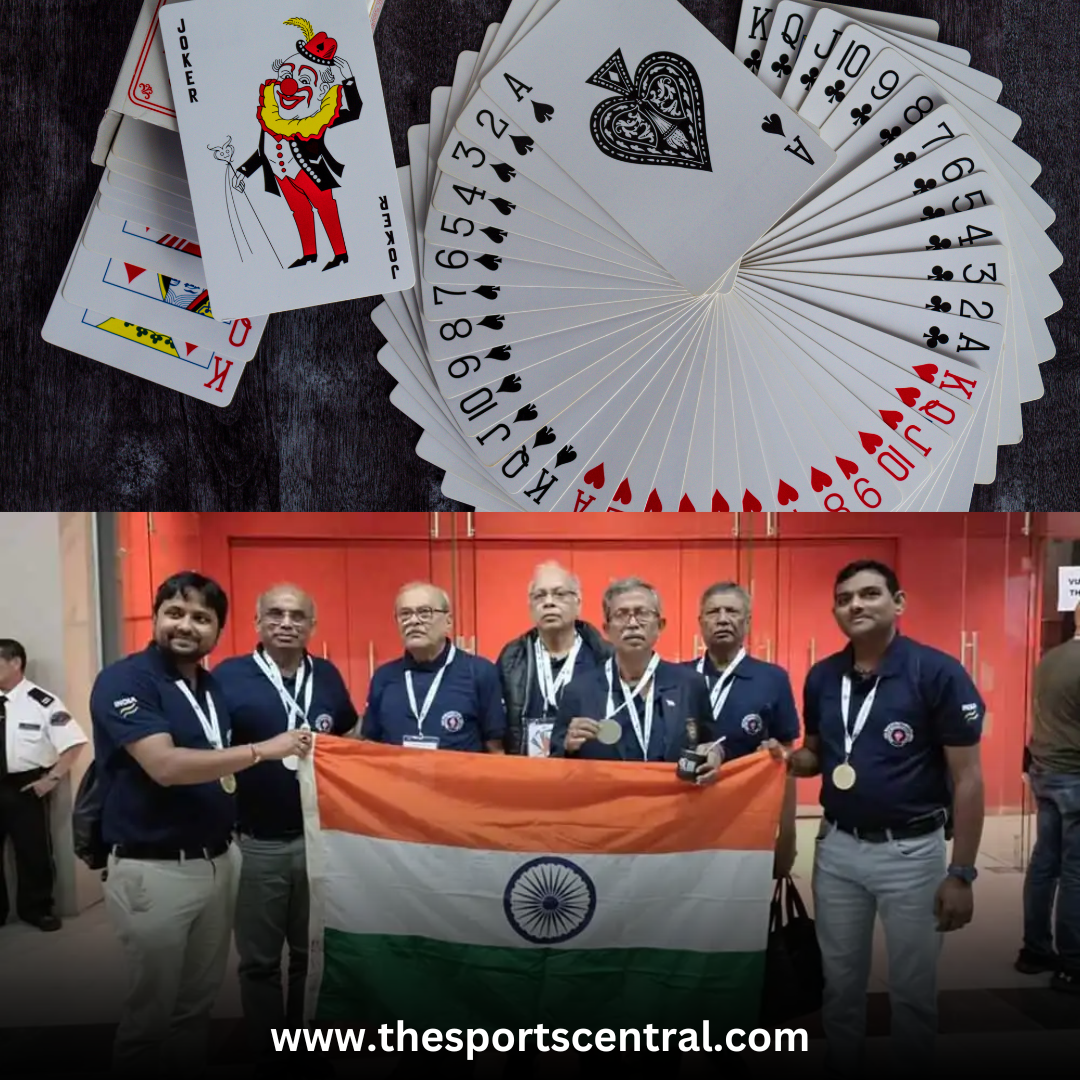India Seniors wrapped up the 16th World Bridge Olympiad with a silver medal after a challenging final match against the USA. The Indian team, consisting of Kamal Mukherjee, Vibhas Todi, Badal Das, Pranab Bardhan, Arun Bapat, Ravi Goenka, and non-playing captain Girish Bijoor, fought hard but fell short with a final score of 165-258 in favor of the USA.
The final, a 96-board match, spanned two days and was divided into six segments. India and the USA remained neck and neck through the first two segments, keeping the audience on edge. The competition was fierce, with both teams showcasing their strategic depth and mental agility. However, the USA gained a decisive edge in the third segment, scoring 53-7 IMPs (International Match Points). This strong lead propelled the American team forward, and despite India’s determined efforts, they could not close the gap. The USA maintained its dominance through the remaining segments, ultimately securing the gold.
Indian Team’s Performance and Journey
The Indian seniors displayed remarkable skill and resilience throughout the tournament. Each player brought their unique strengths to the table, contributing to the team’s overall success. Kamal Mukherjee and Vibhas Todi, seasoned players with deep strategic knowledge, formed a solid pairing. Their coordination and intuitive play were instrumental in India’s journey to the final. Badal Das and Pranab Bardhan, known for their aggressive bidding style, added a competitive edge, often putting pressure on opponents.
Arun Bapat and Ravi Goenka also played a crucial role, showing great composure in high-pressure situations. Non-playing captain Girish Bijoor provided strategic guidance, analyzing the game dynamics and advising the team throughout the tournament. This collaborative effort took India to the silver, marking one of their best finishes in recent bridge competitions.
Key Moments in the Final
The final match saw both teams showcase exceptional skill, but the USA managed to seize key opportunities. In the first two segments, India kept pace, matching the USA point for point. Each board was closely contested, with no team gaining a significant lead. However, the third segment proved pivotal. The USA capitalized on a few critical errors from the Indian team, leading to their 53-7 score advantage. This segment created a wide gap, shifting the momentum firmly in favor of the USA.
Despite the setback, the Indian team did not relent. They fought through each subsequent segment, trying to recover the lost ground. Their resilience was commendable, but the USA’s solid defense and precise bidding strategies allowed them to maintain control of the game. By the final segment, the USA’s lead was unassailable, and India had to settle for silver.
The Rise of Indian Bridge on the Global Stage
India’s performance in the World Bridge Olympiad reflects the country’s growing presence in international bridge. The silver medal in such a prestigious event highlights the skill and potential of Indian players. Over recent years, India has made steady progress in the bridge world, developing a robust competitive framework and nurturing talent at the grassroots level.
Indian players like Pranab Bardhan and Badal Das have been instrumental in popularizing bridge in India. Their success has inspired younger players and drawn attention to bridge as a competitive sport. The sport is gaining traction, with more players participating in national and international events. This silver medal will likely inspire further interest in bridge across India, encouraging more players to pursue the game seriously.
Young Indian Players Shine in Pairs Events
While the seniors were competing in the final, India’s young duo, Sanjit Dey and Binod Shaw, made waves in the pairs events held alongside. This competition marked their debut on the international stage, and they emerged as top performers in both pairs events. Their success in these events showcases the potential of India’s younger generation in bridge.
Sanjit and Binod’s achievement is significant for Indian bridge, as it points to the depth of talent coming up through the ranks. Their performance reflects their preparation, skill, and adaptability, especially given that this was their first international competition. They finished on a high note, gaining recognition and valuable experience that will likely fuel their future careers in bridge.
USA’s Dominance in the World Bridge Olympiad
The USA’s victory in the World Bridge Olympiad final reinforces its status as a powerhouse in the bridge world. With a legacy of strong players and a well-developed competitive framework, the USA has consistently performed well in international bridge tournaments. The American team’s strategy, particularly in the third segment, displayed their expertise in reading the game, capitalizing on opportunities, and executing precise bids.
Their ability to turn a close match into a decisive win speaks to their experience and mental fortitude. The USA’s success at the World Bridge Olympiad serves as a benchmark for other nations, setting a high standard in terms of skill, strategy, and competitive spirit.
The Future of Bridge in India
India’s strong showing in the World Bridge Olympiad and the success of young players like Sanjit and Binod indicate a promising future for bridge in India. The country has invested in developing the game at various levels, with bridge clubs, national tournaments, and coaching programs becoming more accessible.
The Bridge Federation of India has played a crucial role in nurturing talent and promoting bridge as a serious sport. The organization’s efforts to encourage youth participation and provide training are beginning to pay off, as evidenced by India’s impressive performance in the Olympiad. Moving forward, further investment in training facilities, mentorship, and exposure to international competition will be essential to maintaining and growing India’s presence in the global bridge scene.
Lessons Learned and Path Forward
For India’s senior team, the silver medal is both a proud achievement and a learning experience. Competing against top teams like the USA provides valuable insights into advanced strategies and the mental discipline required at the highest level of play. These experiences will help Indian players refine their skills and prepare for future competitions.
As India continues to build its bridge program, exposure to international tournaments will be key. By participating in events like the World Bridge Olympiad, Indian players gain firsthand experience in high-stakes matches, where they learn to navigate intense pressure and complex bidding situations. These lessons will contribute to India’s long-term success in bridge.
Conclusion
India’s silver medal at the 16th World Bridge Olympiad is a milestone in the country’s bridge journey. The team’s performance, led by players like Kamal Mukherjee, Vibhas Todi, and Pranab Bardhan, demonstrates the skill and resilience of Indian bridge players on the world stage. Despite falling short in the final against the USA, the Indian team’s achievements reflect a bright future for bridge in India.
The success of young players Sanjit Dey and Binod Shaw in the pairs events also highlights the potential of India’s next generation. Their impressive debut adds to the momentum, showing that Indian bridge has depth and promise.
The World Bridge Olympiad has left India with valuable experiences and a renewed sense of purpose. With continued effort and investment, India’s bridge community is well-positioned to grow, inspire new talent, and pursue even greater heights in international bridge.











I think other website proprietors should take this web site as an model, very clean and fantastic user genial style and design, as well as the content. You’re an expert in this topic!
I like your writing style truly enjoying this internet site.
I really appreciate your work, Great post.
This is a very good tips especially to those new to blogosphere, brief and accurate information… Thanks for sharing this one. A must read article.
Wonderful website. A lot of useful information here. I am sending it to a few buddies ans also sharing in delicious. And certainly, thank you to your effort!
Thanks for a marvelous posting! I really enjoyed reading it, you could be a great author.I will ensure that I bookmark your blog and will come back someday. I want to encourage one to continue your great work, have a nice weekend!